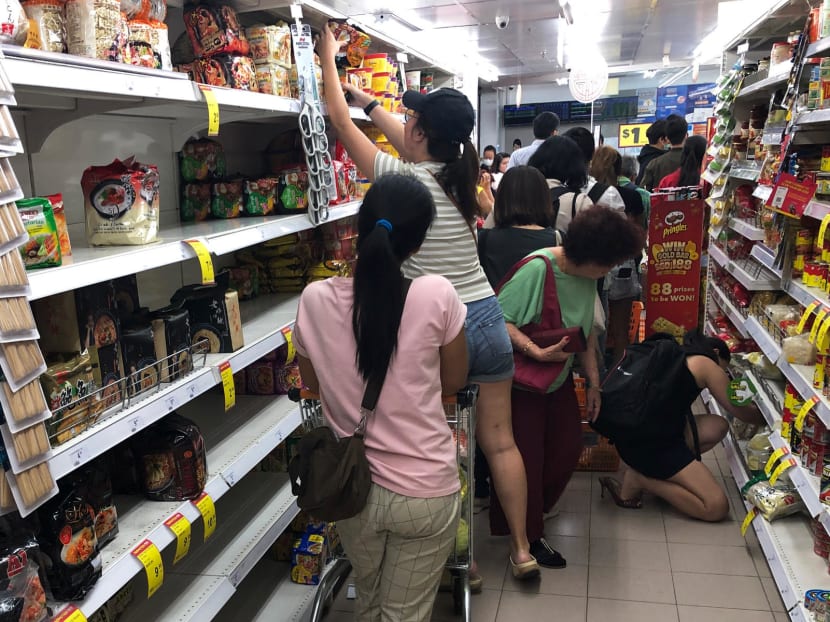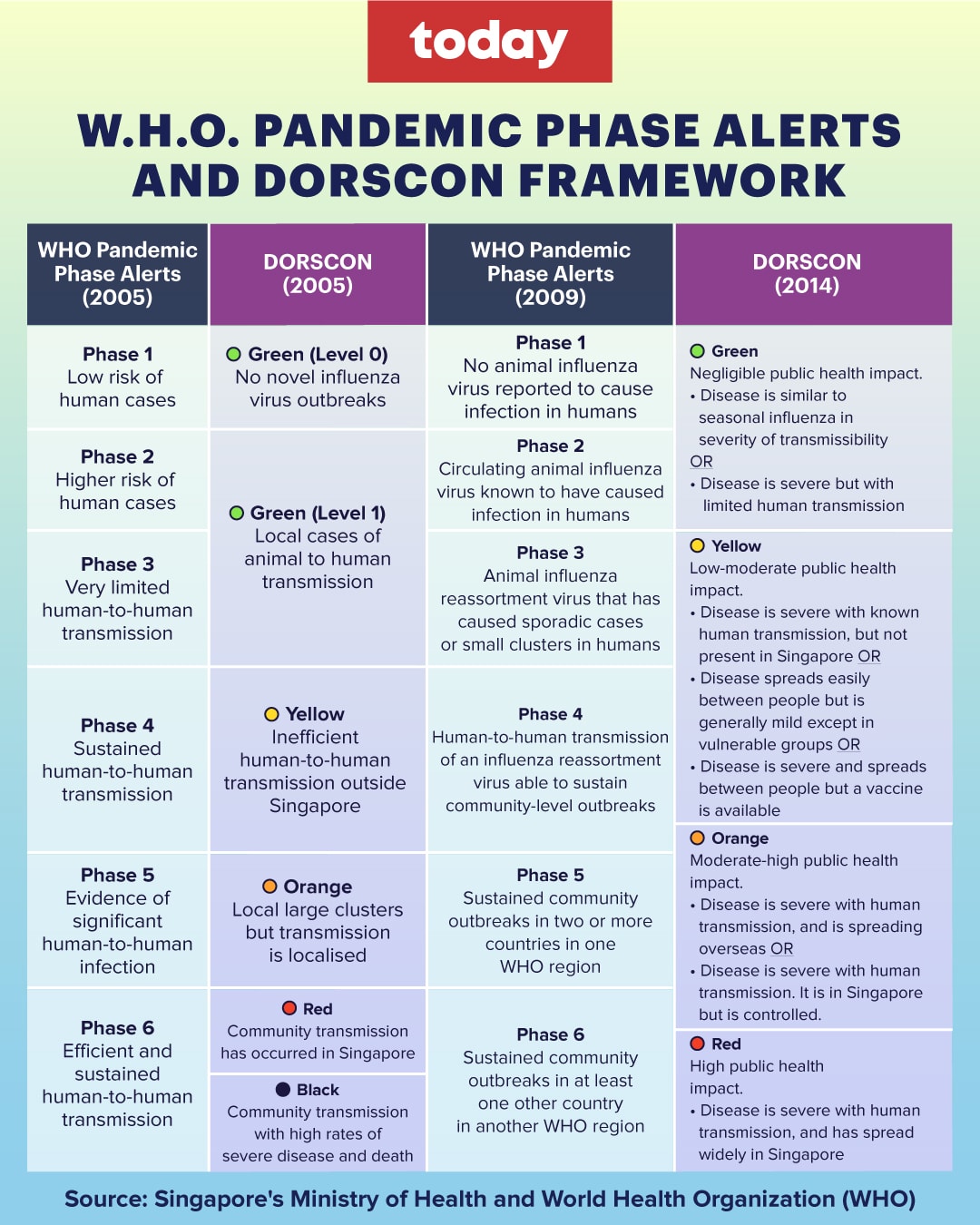Commentary: In reviewing the Dorscon framework, let's not throw the baby out with the bathwater
When the Covid-19 multi-ministry task force (MTF) announced that the Disease Outbreak Response System Condition (Dorscon) level was to be adjusted from Orange to Yellow on April 26, it was met with a general sense of bemusement.

The public announcement of Dorscon levels had the unintended consequence of inducing public anxiety during the Covid-19 pandemic and sparked panic buying at supermarkets.
When the Covid-19 multi-ministry task force (MTF) announced that the Disease Outbreak Response System Condition (Dorscon) level was to be adjusted from Orange to Yellow on April 26, it was met with a general sense of bemusement.
Was Dorscon still relevant and did this adjustment really matter?
This question was obliquely answered by Health Minister Ong Ye Kung in Parliament on May 9, when he mentioned that the Dorscon framework was a tool for government agencies to coordinate and execute the Government’s response to outbreaks.
He expressed his concern that the public announcement of Dorscon levels had the unintended consequence of inducing public anxiety during the Covid-19 pandemic, and added that the Dorscon framework would be reviewed.
WHAT IS THE DORSCON FRAMEWORK?
Following the Severe Acute Respiratory Syndrome (Sars) epidemic in 2003 and the avian influenza A(H5N1) outbreak in Indonesia in 2004, the Ministry of Health (MOH) developed the National Influenza Pandemic Readiness and Response Plan in 2005, which described the Dorscon framework for the first time.
This would communicate the extent of the risk faced by the community, and be tied to the public health actions deemed necessary to mitigate the impact of these infectious diseases.
It made intuitive sense then — and now — to have an easily understandable public alert system for infectious diseases of pandemic potential, in addition to its primary role in focusing governmental outbreak responses.
There were five Dorscon alert levels initially, which at the time were coupled to the six World Health Organization (WHO) pandemic alert phases that were developed in 1999 and revised in 2005 (Table 1).
These levels were thus pegged to the transmissibility — but not virulence (that is, the deadliness of an infection) — of an epidemic virus.
In 2009, WHO tweaked the six pandemic alert phases for more specific and understandable trigger points, at the same time adding in a “post-peak period” and “post-pandemic period” for the provision of guidance on potential public health actions following the peak of a pandemic wave.

EVOLUTION OF THE DORSCON FRAMEWORK
The Dorscon framework was first tested in a “no duff” situation during the 2009 influenza A(H1N1) pandemic.
The Dorscon level was duly raised to Orange on April 30, 2009 at the height of the pandemic in Singapore, but was quickly lowered to Yellow 11 days later in view of the relatively modest impact of the pandemic in Singapore.
In this initial test, it was quickly decoupled from the WHO pandemic alert system —the WHO had raised its alert to Phase 6 and declared a pandemic only on June 11, 2009.
Although the novel influenza virus had spread rapidly worldwide, its impact was mild especially relative to the prior experience of the 1918 influenza pandemic and the high mortality rates seen with avian influenza H5N1.
This led to criticisms of the WHO pandemic alert system for its failure to include virulence as a criterion along with geographic spread.
In 2014, MOH revised its National Influenza Pandemic Readiness and Response Plan and specifically addressed the issue of the virulence and public health impact of a potential epidemic virus.
For a virulent virus capable of causing severe public health impact, more strict and sustained measures aimed at containing its spread could be implemented.
Conversely, for a mild disease with low public health impact, a rapid shift towards reducing community impact rather than maintaining containment measures that were more restrictive and costly could be made.
This was reflected in the modifications made to the Dorscon framework, which no longer mapped closely to the WHO pandemic alert phases and had the “black” colour code removed.
While the new Dorscon framework was somewhat more complicated, with different potential scenarios and linked public health actions for each colour-coded level, it arguably made more sense and remained relatively easy to understand for the public.
DORSCON AND COVID-19
This modified framework was tested during the Covid-19 pandemic.
With the appearance of the highly transmissible Sars-CoV-2 capable of causing severe disease and death in Wuhan at the end of 2019, the Dorscon level was raised to Yellow and then quickly and publicly to Orange on Feb 7, 2020 when community cases of Covid-19 without epidemiological links to prior cases were diagnosed in Singapore.
However, it stayed at Orange for the next two years, and was barely mentioned in official updates throughout this period, during which Singapore experienced a lockdown and numerous restrictions on social activities and travel amidst large waves of infections and deaths caused by the Delta and Omicron variants of SarsS-CoV-2.
It seemed clear to many people in the community that the publicly published criteria for Dorscon Red had been broadly met at various points over the past two years.
But the MTF had just as stolidly denied this — then Health Minister Gan Kim Yong had clarified that Red meant “uncontrollable outbreaks” — even as they had implemented virtually all the public health actions linked to Red in the revised National Influenza Pandemic Readiness and Response Plan of 2014.
This led initially to many satirical social media posts on the multiple shades of Orange, but eventually to a numbed amnesia of Dorscon until the recent MTF announcement.
MOVING FORWARD
Can we ditch the Dorscon framework altogether or else not publicise it?
This has more drawbacks than benefits, as an individualised risk communication strategy for each major epidemic will still be greatly aided by an overarching predictable risk impact framework.
As an example, the various phases to reopening Singapore during this pandemic — while enabling a more granular approach — are highly specific to Covid-19 and also confusing with its multiple permutations.
Looking ahead, it is clear that the original aims of the Dorscon framework remain valid even with the experience of the current Covid-19 pandemic.
The issue of escalating public anxiety occurring with the raising of Dorscon levels is a predictable phenomenon and may be mitigated by better public communication.
Stockpiling and “panic buying” also occurred when new social distancing restrictions were announced in late 2020, even though the Dorscon level stayed at Orange.
In the process of reviewing the Dorscon framework, it will be important that the baby is not thrown out with the bathwater.
The public and the government agencies should have the same understanding of what each level means and perhaps more importantly, the criteria for moving between levels.
Certain lessons from Covid-19, such as the importance of the capacity of the healthcare system and our supply chains, can be more clearly articulated for a future Dorscon framework and pandemic preparedness plan.
If the Dorscon framework is revised, it should not end up being more complicated and difficult to follow in an effort to capture more potential eventualities and scenarios.
ABOUT THE AUTHOR:
Associate Professor Hsu Li Yang is vice-dean of global health and programme leader of infectious diseases at Saw Swee Hock School of Public Health, National University of Singapore.






